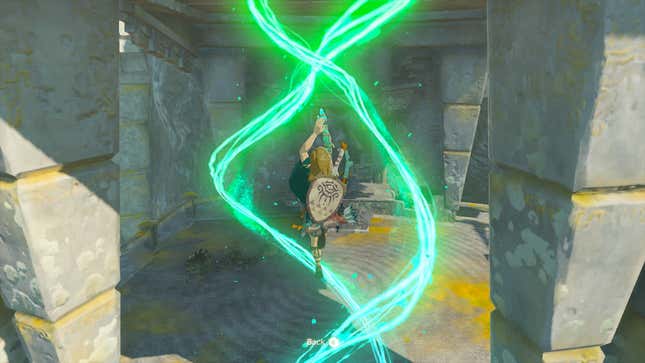The Legend of Zelda: Ocarina of Time is often heralded as one of the best adventure games of the past 25 years. With the nefarious Ganon once again scheming to conquer the land, it’s up to Link to traverse through time, space, and yet another aggravating water temple to save the Kingdom of Hyrule. While the epic for the N64 is celebrating a major birthday this year, inspiring tribute mash-up videos and social media celebrations, another classic Zelda title is quietly celebrating a major milestone of its own.
In November 2013, A Link Between Worlds made its way onto the Nintendo 3DS, reimagining what a 2D Zelda title could be. It follows many of the same tropes as most games in Nintendo’s storied RPG series, embracing the intense dungeon-crawling and puzzle-solving of its spiritual predecessor, 1992’s A Link to the Past for the Super Nintendo. But it stands the test of time because it embraces the experimental nature of the series, offering a plethora of gimmicks and mechanics were early forerunners of the innovations seen in Breath of the Wild and Tears of the Kingdom so amazing.
The story has all the familiar Zelda elements, with a welcome splash of oddness. The sorcerer Yuga seeks to revive the series-staple villain Ganon, kidnapping Zelda and the Seven Sages to get the ritual going. To keep Link from foiling her plans, she imprisons him in a painting—except Link manages to get his hands on a magic bracelet that allows him to move through walls to get to previously unreachable spots. In retrospect, it feels like an early version of the ascend ability in Tears of the Kingdom, but instead of going up you move horizontally. That item adds surprising depth to the trials Link needs to complete, forcing you to scout every vantage point and possible interaction you can with the cliffs and walls littering Hyrule.

Unlike other Zelda games, where weapons and equipment stay with you forever, A Link Between Worlds adds another layer of difficulty by taking them away when you die. Ravio, a merchant with purple bunny swag, will rent you classic items like the Hookshot, boomerang, and bow, but wants them back when you perish—unless you can afford to buy them outright. In some ways, it’s an early iteration of the durability mechanic present in Breath of the Wild and Tears of the Kingdom, the merits of which have sparked endless debate among players since the earliest days of the Switch.
In the early game, your Rupee wallet won’t be fat enough to keep your toys, so dungeons have an extra level of terror. I still tremble at the thought of the East Palace’s moving platforms, where you need to dodge a barrage of arrows while timing your movements to proceed. The impeccable dungeon design, which balances risk and reward makes A Link Between Worlds one of the most memorable and important Zelda games.
It wasn’t all smooth sailing though, and the game went through a fair bit of development trouble. Skyward Sword took most of the Zelda development team, with just three members left to come up with the next 3DS title. After about six months, they had only come up with a vague concept of using “communication” to interact with other players, but went ahead with pitching the idea to series creator Shigeru Miyamoto.

“As soon as we started the presentation, I could see Miyamoto-san’s facial expression rapidly darkening,” Shiro Mouri, assistant director and program leader said in an undated Iwata Asks interview on Nintendo’s official site. “I thought, ‘This is bad…’ And then at the end, he said, ‘This sounds like an idea that’s 20 years old,’ that was the final blow. We were down on the floor.”
Back at the drawing board, the Zelda team settled on the walking canvas idea, building upon what a traditional 2-D game with Link and the Master Sword could be. Making more items available at the start—even if temporarily—would keep players from getting stuck. The top-down angle of A Link to the Past kept players from being able to see faces and all the facets of the environment, so the camera in Link Between Worlds is titled just a little bit. This allowed players to see the emotions of the inhabitants of Hyrule, find unique angles for puzzles, and make the world environment feel more alive.
Like most of the Game Boy entries, A Link Between Worlds gets very little recognition compared to Zelda’s flashier, three-dimensional iterations, even though the story, gameplay, and dungeon designs rank among the best the series has to offer.
Link’s Awakening got a much-deserved remaster back in 2019, allowing a new generation to experience Link’s island adventure with vibrant color and updated graphics. It’s high time A Link Between Worlds got the same treatment.

